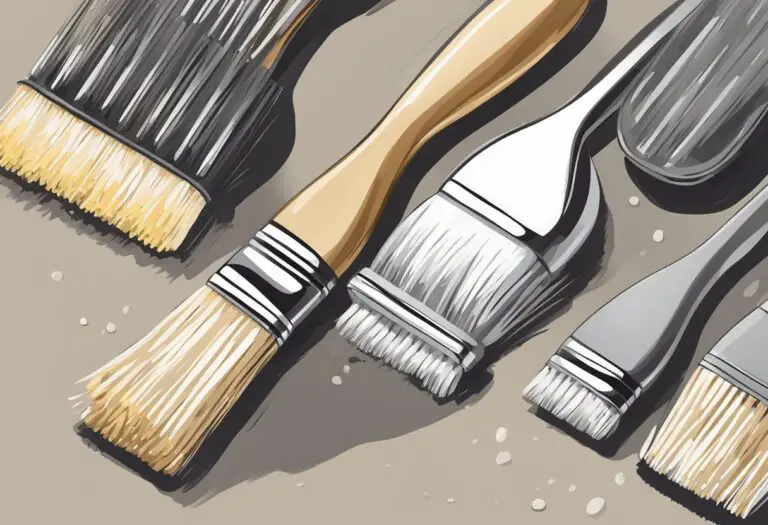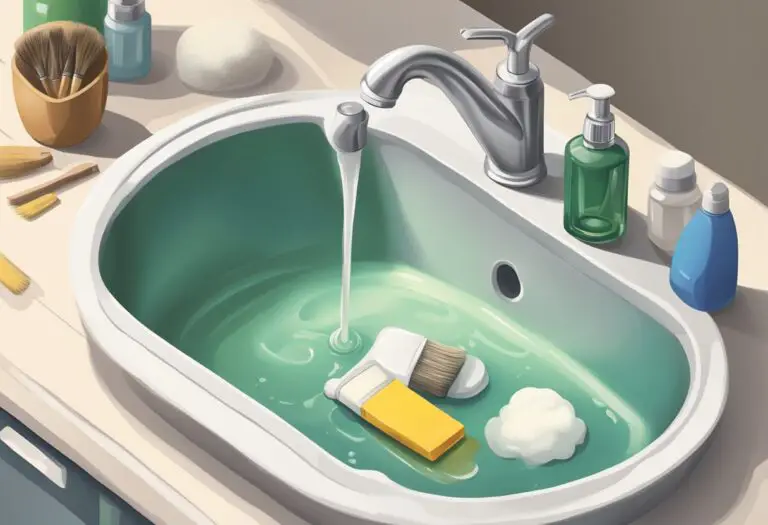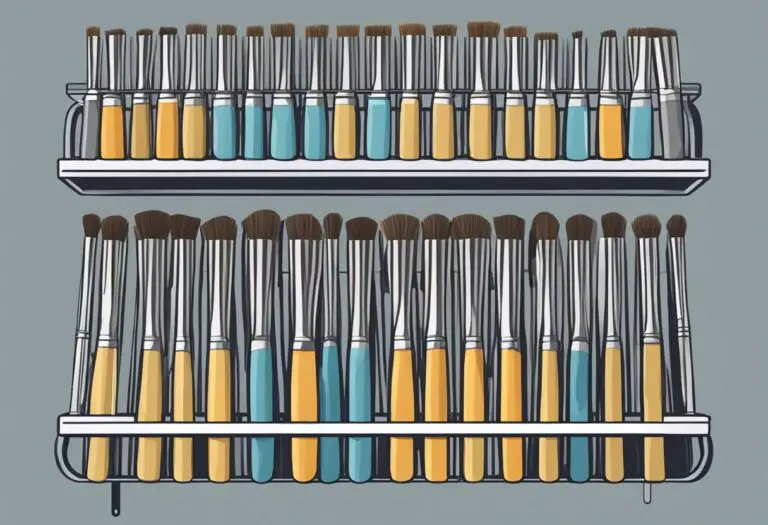What are the best techniques for storing paintbrushes to maintain their shape?
Best Techniques for Storing Paintbrushes to Maintain Their Shape
Proper storage of paintbrushes is essential for maintaining their shape and prolonging their lifespan. Whether you are a professional artist or a hobbyist, you want your brushes to stay in top condition for as long as possible. However, many people are unaware of the best techniques for storing paintbrushes, which can lead to bristles becoming misshapen or damaged.

One of the most important factors in storing paintbrushes is ensuring that they are clean and dry before being put away. Any leftover paint or moisture can cause the bristles to stick together or become misshapen over time. Once the brush is clean and dry, it should be stored in a way that protects the bristles from being crushed or bent. There are several techniques that can be used to achieve this, depending on the type of brush and the materials available.
In this article, we will explore the best techniques for storing paintbrushes to maintain their shape. We will cover topics such as cleaning and drying brushes, choosing the right storage container, and using protective covers. By following these tips, you can ensure that your paintbrushes stay in top condition and are ready to use whenever inspiration strikes.
Understanding Paintbrush Anatomy

When it comes to storing paintbrushes, it’s important to understand the different parts of the brush and how they contribute to its overall shape and performance. Here are the key components of a paintbrush:
Bristle Types
The type of bristle used in a paintbrush can greatly affect its performance and lifespan. There are three main types of bristles: natural, synthetic, and blended.
Natural bristles are made from animal hair, such as hog or sable. They are known for their ability to hold paint well and create a smooth finish. However, they can be expensive and require more maintenance than synthetic bristles.
Synthetic bristles are made from nylon or polyester and are generally less expensive than natural bristles. They are also more durable and easier to clean. However, they may not hold paint as well as natural bristles and can create a slightly different finish.
Blended bristles combine natural and synthetic materials to create a brush that has the benefits of both types. They are often less expensive than natural bristle brushes and can provide a smooth finish.
Handle Materials
The handle of a paintbrush is often overlooked, but it can affect the overall comfort and control of the brush. Handles can be made from a variety of materials, including wood, plastic, and metal.
Wooden handles are a popular choice because they are comfortable to hold and provide a natural grip. However, they can be affected by moisture and may require more maintenance than other materials.
Plastic handles are lightweight and easy to clean, but they may not provide the same level of comfort as wooden handles.
Metal handles are durable and provide a sturdy grip, but they can be heavy and uncomfortable to hold for extended periods of time.
Understanding the anatomy of a paintbrush can help you choose the right brush for your needs and properly store it to maintain its shape and performance.
Pre-Storage Brush Care
When it comes to maintaining the shape of paintbrushes, proper pre-storage care is crucial. This section covers two important aspects of pre-storage care: proper cleaning and drying techniques.
Proper Cleaning
Before storing paintbrushes, it is important to clean them thoroughly. This not only helps to maintain the shape of the bristles but also prevents the buildup of paint, which can harden and damage the brush over time.
To clean paintbrushes, use a solvent appropriate for the type of paint used. For example, water is suitable for cleaning water-based paints, while mineral spirits or turpentine may be needed for oil-based paints. Dip the bristles into the solvent and work the brush back and forth on a surface, such as a palette or paper towel, to remove as much paint as possible.
Next, rinse the brush with clean water and work the bristles back and forth to remove any remaining solvent. Repeat this process until the brush is clean. Avoid using hot water, as it can damage the bristles.
Drying Techniques
After cleaning, it is important to dry the paintbrushes properly to maintain their shape. Improper drying can cause the bristles to splay or become misshapen, which can make them difficult to use.
To dry paintbrushes, gently squeeze out any excess water or solvent using a clean cloth or paper towel. Avoid twisting or pulling on the bristles, as this can damage them. Then, reshape the bristles with your fingers to ensure they maintain their original shape.
Finally, lay the brush flat on a clean surface to dry. Avoid standing the brush upright, as this can cause water or solvent to seep into the ferrule, which can cause the bristles to loosen or fall out over time.
By following these proper cleaning and drying techniques, you can help ensure that your paintbrushes maintain their shape and are ready to use when you need them.
Storage Solutions

When it comes to storing paintbrushes, it’s important to take proper care in order to maintain their shape and quality. Here are some storage solutions to consider:
Horizontal vs. Vertical Storage
One common question when it comes to storing paintbrushes is whether to store them horizontally or vertically. The answer depends on the type of brush and the material it’s made of.
For natural hair brushes, it’s best to store them horizontally to prevent the bristles from bending or warping. This is because natural hair brushes are more delicate and prone to damage. On the other hand, synthetic brushes can be stored vertically without any issues.
Containers and Protectors
Another important factor to consider when storing paintbrushes is the container or protector used. A good container or protector can help prevent damage to the bristles and maintain the shape of the brush.
One option is to use a brush holder or roll-up case, which allows you to store multiple brushes in one place. These can be made of fabric or leather and come in various sizes and designs.
Another option is to use brush protectors, which are plastic or silicone covers that slip over the bristles of the brush. These can be especially useful when traveling with your brushes.
Overall, the key to storing paintbrushes is to be gentle and careful. By using the right storage solutions, you can help extend the life of your brushes and maintain their quality.
Maintaining Brush Shape

When it comes to storing paintbrushes, maintaining their shape is a crucial aspect. Here are some techniques that can help you keep your paintbrushes in excellent condition:
Use of Brush Shapers
Brush shapers are a great tool to preserve the shape of your paintbrushes. These are typically made of silicone or rubber and come in different sizes to fit various brush shapes. To use brush shapers, simply slide them onto the bristles of your paintbrush, and they will hold the shape of the brush while it dries.
DIY Shape Preservers
If you don’t have access to brush shapers, you can make your own shape preservers using household items. One option is to use a clothespin. Simply clip the clothespin onto the ferrule (the metal part of the brush that connects the bristles to the handle), and the brush will dry in the desired shape. Another option is to use a rubber band. Wrap the rubber band tightly around the bristles, so they stay together in the desired shape.
It’s important to note that regardless of the method you choose, it’s essential to clean your paintbrushes thoroughly before storing them. Leftover paint can cause the bristles to stick together and lose their shape.
By using brush shapers or DIY shape preservers and cleaning your paintbrushes thoroughly, you can maintain their shape and prolong their lifespan.
Long-Term Storage Tips

When it comes to storing paintbrushes for an extended period, there are a few things to consider to ensure they maintain their shape and quality. Here are some tips for long-term storage of paintbrushes:
Climate Considerations
The climate in which paintbrushes are stored can have a significant impact on their lifespan. It is essential to store paintbrushes in a dry and cool environment. High humidity can cause the bristles to become limp, while extreme heat can cause them to become brittle and break.
To avoid these problems, it is recommended to store paintbrushes in a clean, dry, and well-ventilated area. If possible, store them in airtight containers to protect them from dust and other contaminants.
Space Optimization
Proper storage of paintbrushes is essential to maintain their shape and quality. To optimize space and prevent damage to the bristles, it is recommended to store them in an upright position.
One way to achieve this is to use a brush holder or a rack specifically designed for paintbrushes. These holders can be made from a variety of materials, including plastic, wood, or metal. They are available in different sizes and shapes to accommodate various brush sizes and types.
Another option is to use a pegboard or a wall-mounted rack to store paintbrushes. This method is ideal for those with limited storage space and allows for easy access to the brushes.
In conclusion, proper long-term storage of paintbrushes is essential to maintain their shape and quality. By considering climate and space optimization, artists can ensure their brushes remain in excellent condition for years to come.







